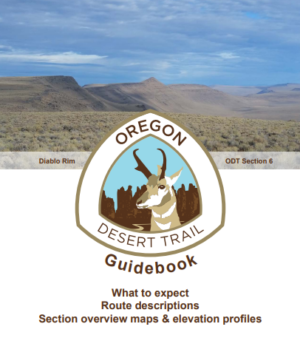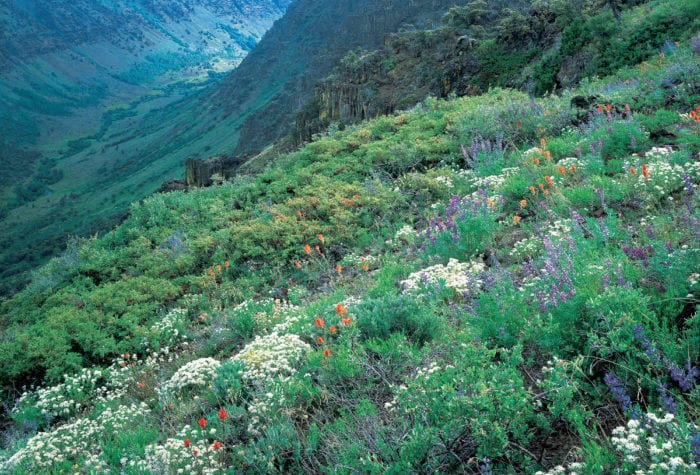Safety Tips
Tyson Fisher Website
Desert Safety
- Drink plenty of water. Eastern Oregon is arid, and you may need to carry more water than you are used to in other environments. Be conservative and carry more than you need until you have a good handle on your body’s needs in this environment. If you are going on a multi-day trip, carry an adequate water purification system and consume plenty of electrolytes (the salts and sugars your body needs to help you absorb the water you are drinking).
- Seek out shade, or carry it with you. Make use of shade for food and water breaks. And, with little to no shade throughout much the desert, consider carrying a sun umbrella to take your shade along with you.
- Cover up. Desert sun can be harsh on a hiker’s skin, so consider covering up with lightweight long sleeves and pants for sun protection.
- Be prepared for temperature swings -Days are hot and nights are cool – even on the hottest days in the desert, the temperatures can drop dramatically when the sun sets. Be prepared for cooler temperatures at night.
- Be mindful in brushy sections. Use a hiking pole or stick to rustle tall grasses as you hike to help alert any snakes, and other wildlife, to your presence and give both of you a chance to move away from an encounter. Wearing tall gaiters can be useful in cross-country sections with heavy vegetation, or in places with difficult bushwhacks, to protect your ankles from both snakes and thorny brush.
- Go easy during the hottest part of the year, or time of the day. Be careful that you don’t plan to engage in strenuous activities during the hottest part of the year, or during the heat of the day. Hiking during the spring or fall can provide more comfortable all-around temperatures for hiking, or, if you’re going mid-summer, consider getting up early or hiking late and being more relaxed at midday. Think siesta!
- Use Verizon cell service. Verizon has the best cell service throughout the high desert. The exception is in the Owyhee region where there is little to no service at all.
- Consider carrying a personal locator beacon. Technology has advanced to the point that hikers can always seek assistance if needed with the use of personal locator beacons.
- Watch your steps and avoid damaging sensitive terrain. Many areas in the high desert are best explored off trail. To minimize impacts of travel through fragile high desert soils, if you see other footprints, don’t follow them. Instead choose a similar bearing and walk a short distance away. Desert soils can be easily impacted, and it only takes a few hikers to start establishing tread in the desert. Be particularly careful not to step on black, knobby crusts on the soil or sand. These cryptobiotic soil crusts perform important ecological roles, including carbon fixation and more, and can be damaged easily.
- Cross fences carefully. Hikers may encounter fences on cross-country hikes in the high desert, and yes, fences are on public lands. Because many of the high desert landscapes are used for grazing and ranching, these fences keep the cattle where they belong. Cross these fences with care. If you encounter gates, leave them as you find them. Please respect the multiple other uses throughout in the desert.
- Avoid driving on wet roads. Waterlogged desert soils can bog down a vehicle in inches or feet of mud. In remote parts of the Oregon Desert, recent precipitation can make some roads impassable, even on flat terrain. Gravel roads can be a better bet when conditions are wet as the gravel can provide extra traction between your car tires and the slick mud. Remember that help in the form of a tow-truck can be hours to days away, and prohibitively expensive in these remote locations.
Leave No Trace Principles
When visiting wild areas, it is imperative that you “take only photographs, leave only footprints” and follow the “Leave No Trace” principles:
- Plan Ahead and Prepare – Know the rules of the area you’re visiting. Research current conditions and weather in the area and always travel prepared for emergencies or inclement weather.
- Travel and Camp on Durable Surfaces – Minimize your impact by sticking to established trails and campsites or durable surfaces such as rock, gravel, dry grasses or snow. Avoid walking off trail through sensitive riparian areas or on steep slopes. Make your camp at least 200 feet from creeks, lakes and rivers, and leave your site as you found it.
- Respect Wildlife – Observe wildlife from a distance to allow them peace in their natural environment. Do not follow or approach them and never feed wild animals.
- Dispose of Waste Properly – Pack it in, pack it out. Inspect your campsite and rest areas for trash or spilled foods. Always pack out toilet paper and hygiene products.
- Leave What You Find – Leave rocks, plants, animals and historical artifacts as you find them. Examine, but do not touch, cultural or historical artifacts such as structures and rock art.
- Minimize Campfire Impacts – Know the current regulations on campfires for the area and follow the rules. When fires are allowed keep them small and in control at all times. Only use sticks from the ground that can be broken by hand. Burn all wood and coals to ash, put out campfires completely, then scatter cool ashes.
- Be Considerate of Other Visitors – Respect other visitors and protect the quality of their experience by being courteous and yielding to other visitors on the trail. Let nature’s sounds prevail by avoiding loud voices and noises. Avoid cliffs and steep areas and be conscious of hikers below you on the trail who may be hurt by any debris that you knock loose.
© 1999 by the Leave No Trace Center for Outdoor Ethics: www.LNT.org.
The Ten Essential Systems
Carrying the Ten Essentials will help you respond positively to an accident or emergency, and safely spend a night—or more—out, if needed. Once known as the Ten Essentials list (developed by The Mountaineers in the 1930s), the list has evolved over time from a list of individual items to a list of functional systems.
- Navigation: Always carry a detailed topographic map of the area you are visiting, and place it in a protective case or plastic covering. Always carry a compass. Other navigational tools include an altimeter or global positioning system (GPS) receiver; other aids include route markers, route descriptions, and other types of maps or photos.
- Sun Protection: Carry and use sunglasses, sunscreen for the lips and skin, and clothing for sun protection.
- Insulation (Extra Clothing): How much extra clothing is necessary for an emergency? The term “extra clothing” refers to garments beyond what you are wearing for the active portion of your outing, the additional layers that would be needed to survive long, inactive hours of an unplanned bivouac.
- Illumination: Even if you plan to return to their cars before dark, it is essential to carry a headlamp or flashlight, just in case. Batteries and bulbs do not last forever, so carry spares of both at all times.
- First-Aid Supplies: Carry and know how to use a first-aid kit, but do not let a first-aid kit give you a false sense of security. The best course of action is to always take the steps necessary to avoid injury or sickness in the first place. At a minimum, a first-aid kit should include gauze pads in various sizes, roller gauze, small adhesive bandages, butterfly bandages, triangular bandages, battle dressing (or Carlisle bandage), adhesive tape, scissors, cleansers or soap, latex gloves, and paper and pencil.
- Fire: Carry the means to start and sustain an emergency fire—a butane lighter or matches in a waterproof container. Firestarters, such as candles, chemical heat tabs, and canned heat, are indispensable for igniting wet wood quickly to make an emergency campfire.
- Repair Kit and Tools: Knives are so useful in first aid, food preparation, repairs, and climbing that every party member needs to carry one. Other tools (pliers, screwdriver, awl, scissors) can be part of a knife or a pocket tool, or carried separately—perhaps even as part of a group kit. Other useful repair items are shoelaces, safety pins, needle and thread, wire, duct tape, nylon fabric repair tape, cable ties, plastic buckles, cordage, webbing, and repair parts for equipment used on your trip.
- Nutrition (Extra Food): For shorter trips, a one-day supply of extra food is a reasonable emergency stockpile in case foul weather, faulty navigation, injury, or other reasons delay the planned return. An expedition or long trek may require more. The food should require no cooking, be easily digestible, and store well for long periods.
- Hydration (Extra Water): Carry extra water and have the skills and tools required for obtaining and purifying additional water. Always carry at least one water bottle or collapsible water sack. Daily water consumption varies greatly. Two quarts (liters) daily is a reasonable minimum; in hot weather or at high altitudes, 6 quarts may not be enough. In dry environments, carry additional water. Plan for enough water to accommodate additional requirements due to heat, cold, altitude, exertion, or emergency.
- Emergency Shelter: If the party is not carrying a tent, carry some sort of extra shelter from rain and wind, such as a plastic tube tent or a jumbo plastic trash bag. Another possibility is a reflective emergency blanket. It can be used in administering first aid to an injured or hypothermic person, or can double as a means of shelter.
Adapted from Mountaineering: Freedom of the Hills, published by Mountaineers Books.

Oregon Desert Trail Guidebook
The Oregon Desert Trail is a route through the desert, designed by ONDA, that can be enjoyed in small segments over time, or all at once.
This guidebook contains printable maps, detailed route information, driving directions, safety advice, a guide to water caching, a wealth of cultural and natural history notes and a whole lot more. ONDA provides these extensive resources as free downloads to encourage safe, responsible recreation and help more people appreciate high desert wonders.
Hike Difficulty Ratings
This is the rating system ONDA uses when we describe hikes.
- 1 – Very Easy – Like a walk in your local city park. Trail surface is generally flat and level.
- 2 – Easy – Trail is generally flat, with some rocky terrain and slight elevation gain.
- 3 – Moderate – Trail may include rocky or loose terrain, with steep sections and moderate elevation gain.
- 4 – Challenging – Trail is steep and rocky, with elevation gain of more than 1000 feet. May feature rock scrambles or other challenging features. Trekking poles recommended.
- 5 – Extremely Challenging – Off-trail travel. Terrain is variable and potentially steep. Good map and compass navigation, backcountry travel skills a must.
